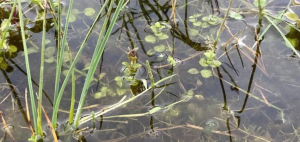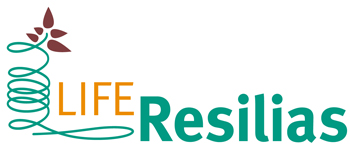

It is now clear that completely eradicating water crassula is not feasible in many cases. The European LIFE project Resilias is therefore committed to controlling this invasive exotic species by breaking its dominance. The project has been running for a few years now and in this article on Nature Today project leaders Laura van Veenhuizen and Mariëlle van Riel share progress and findings.
Within the project, ecologists started work in three sample areas: the old agricultural area Akkerenven of Staatsbosbeheer, the water catchment area of Evides in Halsteren in Brabant and two dune valleys in Zeeland's Zeepe near Burgh-Haamstede. Mariëlle van Riel: "The ecosystem resilience approach consists of a number of steps. From identifying and addressing the sources of eutrophication, to breaking the dominance and then (re)introducing native plant species to prevent regrowth, and the coming to dominance, of water scrassula. When selecting sample areas, we did not only look at areas where water scrassula is dominant. In fact, for the ecosystem approach, it is also important that the area is not too nutrient-rich. Those areas are not suitable for the LIFE Resilias approach, because water scrassula thrives too well there and therefore eventually wins out over native vegetation anyway."
Step 1: bringing back attendance
Laura: "In the areas, we first started with a baseline measurement. This included looking at vegetation levels, water quality, soil quality and whether there were amphibians in the area. Then - when the water level was low - we removed as much water crassula as possible. In 2019 this was done in the Akkerenven, in the summer of 2020 it was Halsteren's turn and in Zeepe we removed the exotic species in July 2022."
The first step in the ecosystem approach to water scrassula is to reduce the presence of the exotic to more than 95 per cent; breaking its dominance. This can be done by excavating the infestation with a machine, placing tarpaulins or treating with hot water. These methods by themselves are not effective in completely eliminating water scrassula, but they reopen dense stands. Where possible, fertilisation sources are also adjusted to reduce available nutrients.
Step 2: introducing native plant species
Laura: "Bringing in competitors is an important next step. Here, we choose native plant species that suit the ecosystem's habitat conditions. It is important to do this as soon as possible after removing the water crassula, otherwise the exotic species will have a chance to return. For planning purposes, this is really still a challenge to get it right. For instance, we remove the water crassula when the water level is lowest, which is usually in the driest period, but then again it is difficult to plant native riverbank species."
"In the example area Akkerenven, we planted riparian weeds in 2019 and opted for a second round in 2020. It had then been dry for a long period and that worked out a bit less well for the bank weeds, giving the water crassula a bit more space again. In Halsteren, we sowed the high banks in 2020 with a native grass herb mixture. In the water layer, we spread riparian weeds and from another project we also received small amounts of other species to deploy. These included marsh deer hay and peel fern."
Mariëlle: "In Zeepe, I also planted shore herbs. We also scattered grass clippings from the dune valley on the edges. We repeated this again a year later, because we were a bit unlucky to have two very wet years in a row. Dry and wet years cannot be predicted in advance, but they do have an effect on this ecosystem approach. That is now apparent."
Step 3: monitoring the areas
Vegetation samples are now collected at least three times a year in the three sample areas. Mariëlle: "In each time exactly the same sample areas, we measure the percentages of presence of water crassula. We also measure water quality, because water scrassula also grows underwater. This way, we see how much CO2 growing in the water and what plant nutrients it contains. We do the same on the banks, but with soil quality."
Laura: "We look at the whole area in our ecosystem approach. After all, the environment of the area in which we work is influential. For instance, the Akkerenven had become super nutrient-rich via a ditch that flowed into the area from a farm. So you have to do something with that if your approach is to be successful."
Monitoring of the sample area in Halsteren shows that the water crassula is still there now. Laura: "It has also never been the goal to eliminate the 100%. We want to break the domination and in that respect, we think it is a very good sign that we now see that the native vegetation is catching on very well. It is still exciting, though, because we have now had another very wet year. The grasses we had sown were completely under water as a result, so you just have to see how that works out. But our preliminary conclusion in this area is that the ecosystem approach works here."
Laura: "In Zeepe, after the first year, we saw that the riparian weeds caught on very well. We were very excited then and got beautiful underwater mats. The year after that, the water crassula did reappear and now we see that the water crassula is once again becoming dominant in the large pond where the southern part falls dry in summer. In the part that remains submerged, we see that bankweed is doing better. In the small pond in the area, shore weed is also still in good shape, but there too we see water crassula returning. So the dune valleys may be too nutrient-rich for the ecosystem approach after all. In the area around the sample area, there is also still a lot of water crassula and when the water is high, it soon connects and the exotic species regains easy access. But we keep monitoring it and we also don't know what the weather will do next year..."
Akkerenven was for implementation 100% water crassula. Mariëlla: "The riparian weeds have grown there nicely and the water crassula are also coming back a bit now. They are really in the middle of the competition for food and space at the moment. On the northern side, the water crrassula seems to be winning and on the southern side the bank weed is in better shape. So we don't yet know which way it will turn, which does make it exciting. What is interesting to see though: we are also seeing more other native species emerging on their own, because they have the space to do so."
This LIFE project of Bargerveen Foundation and Bosgroep Zuid Nederland will run until 2027.

